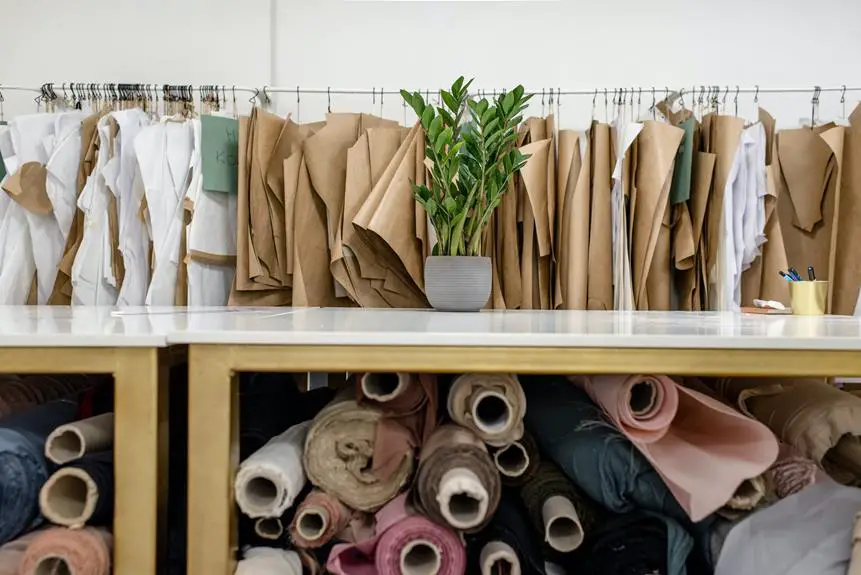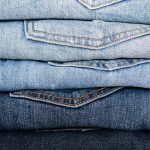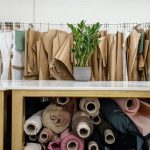When considering the ideal fabrics for your operations, it's crucial to weigh a multitude of factors that contribute to your success.
The selection of fabrics for manufacturers, distributors, wholesalers, and retailers requires a keen understanding of durability, cost-effectiveness, trend relevance, environmental sustainability, supply chain compatibility, market demand, and regulatory compliance.
Mastering fabric selection is pivotal in meeting the diverse needs of your clientele and ensuring the efficiency and effectiveness of your operations.
By carefully evaluating these considerations, you can optimize your fabric choices to align with industry standards and consumer expectations, ultimately propelling your business towards sustained growth and success.
Key Takeaways
- Prioritize durability and performance when selecting fabrics
- Fabrics should provide comfort, breathability, and moisture-wicking properties
- Factor in cost-effectiveness to maximize profitability
- Stay attuned to trend and fashion relevance to meet customer demands
Importance of Fabric Selection
When selecting fabrics for your business, the importance of fabric selection can't be overstated. Material selection plays a crucial role in the success of your products. The fabric suitability directly impacts the quality, performance, and overall appeal of the end product. It's imperative to consider various factors such as the intended use of the fabric, the specific requirements of your target market, and the manufacturing processes involved.
The right fabric can enhance the functionality, durability, and aesthetic appeal of your products, ultimately influencing customer satisfaction and brand reputation.
Furthermore, material selection directly affects production costs, as different fabrics have varying price points and may require specific handling or treatment during manufacturing. Additionally, the environmental impact of the chosen fabric should also be taken into account, aligning with the growing demand for sustainable and eco-friendly materials. Therefore, meticulous fabric selection is essential for not only meeting market demands and quality standards but also for optimizing production processes and ensuring environmental responsibility.
Durability and Performance
When considering fabrics for your products, it's essential to prioritize durability and performance.
The longevity of materials, their quality under stress, and their performance in use are crucial factors to evaluate.
Longevity of Materials
As a manufacturer, distributor, wholesaler, or retailer, you need fabrics that exhibit exceptional durability and performance over time. When considering the longevity of materials, it's crucial to prioritize long term wear and fabric maintenance. Here are key factors to consider:
- Fiber Strength: Opt for fabrics with high tensile strength to withstand wear and tear.
- Colorfastness: Choose materials that maintain color vibrancy even after multiple washes.
- Abrasion Resistance: Look for fabrics that can withstand friction and resist pilling.
- Easy Care: Select fabrics that are easy to maintain and require minimal special treatments.
- Environmental Impact: Consider eco-friendly options that are durable and sustainable, aligning with consumer demand for responsible products.
Quality Under Stress
To ensure quality under stress, prioritize fabrics that exhibit exceptional durability and performance over time. Fabric strength is crucial for manufacturers, distributors, wholesalers, and retailers seeking long-lasting products.
Stress testing is essential to assess how well a fabric can withstand wear and tear, repetitive use, and various environmental conditions. Look for fabrics designed to maintain their integrity and functionality even when subjected to rigorous use. Consider factors such as abrasion resistance, tear strength, and colorfastness when evaluating fabric options.
Choosing fabrics with superior durability not only ensures customer satisfaction but also minimizes the need for frequent replacement, reducing overall costs and environmental impact. By prioritizing fabrics with outstanding performance under stress, you can provide high-quality products that meet the demands of your discerning clientele.
Performance in Use
You need fabrics that demonstrate exceptional durability and performance to ensure long-lasting products for your clientele. When selecting fabrics for your products, consider the following key factors:
- Comfort and breathability: Fabrics that provide comfort and breathability are crucial for ensuring that your clientele feels at ease when using your products.
- Moisture wicking: Fabrics with moisture-wicking properties help in keeping the users dry and comfortable, making them suitable for various activities and environments.
- Insulation: Fabrics that offer insulation help in regulating body temperature, ensuring that your products are suitable for different weather conditions.
- Durability: Opt for fabrics known for their durability to ensure the longevity of your products, reducing the need for frequent replacements.
- Performance: Choose fabrics that offer high performance in terms of wear and tear, ensuring that your products maintain their quality over time.
Cost-Effectiveness
When sourcing fabrics for your business, factor in cost-effectiveness to maximize profitability. Implementing cost-saving techniques and focusing on production efficiency are essential to maintain a competitive edge in the market. Opt for fabrics that offer a balance between quality and cost, as this can significantly impact your bottom line.
Consider the total cost of ownership, including expenses related to production, transportation, storage, and waste management. Look for fabrics that are durable and easy to work with to minimize material waste and enhance production efficiency. Additionally, explore sustainable fabric options that not only align with your business values but also reduce long-term costs through environmentally friendly practices.
Collaborate closely with your suppliers to negotiate favorable pricing, bulk discounts, and favorable payment terms. Regularly review your fabric sourcing strategy and stay updated on market trends to identify opportunities for cost optimization.
Trend and Fashion Relevance
While prioritizing cost-effectiveness in fabric sourcing is crucial, it's equally vital to stay attuned to trend and fashion relevance in order to meet customer demands and preferences effectively. Trend analysis and fashion forecast play a pivotal role in ensuring that the fabrics chosen align with the current market preferences and styles. By staying updated on the latest trends and fashion forecasts, you can make informed decisions about the types of fabrics that will be in high demand, thus maximizing your business's potential for success.
Here are some key reasons why trend and fashion relevance should be a priority in fabric sourcing:
- Meeting Customer Preferences: By incorporating trendy fabrics into your products, you can cater to the evolving preferences of your target audience.
- Enhancing Brand Reputation: Utilizing fashionable fabrics can elevate your brand's image and position it as a trendsetter in the industry.
- Maximizing Sales Potential: Trendy fabrics are more likely to attract customers and drive sales, leading to greater revenue opportunities.
- Staying Ahead of Competitors: Keeping up with fashion relevance allows you to outpace competitors and maintain a competitive edge in the market.
- Adapting to Seasonal Changes: Trend analysis enables you to adapt your fabric sourcing strategy to seasonal shifts in fashion trends, ensuring ongoing relevance.
Environmental Sustainability
To ensure that your fabric sourcing aligns with environmental sustainability, it's imperative to regularly assess the eco-friendliness of the materials you utilize. Embracing eco-friendly options and sustainable sourcing practices can significantly reduce the environmental impact of your operations.
Look for fabrics made from renewable resources, such as organic cotton, hemp, bamboo, and wool, as they're biodegradable and have a lower carbon footprint. Additionally, consider recycled fabrics, which help divert waste from landfills and reduce the need for virgin materials. Tencel, a fiber made from sustainably sourced wood pulp, is another excellent eco-friendly choice due to its closed-loop production process, which minimizes environmental impact.
When evaluating fabric suppliers, inquire about their sustainability initiatives and certifications, such as Global Organic Textile Standard (GOTS), OEKO-TEX Standard 100, or bluesign system. These certifications ensure that the fabrics are produced using environmentally and socially responsible practices. Collaborating with suppliers who prioritize sustainability not only aligns with your environmental goals but also communicates your commitment to conscious consumerism.
Supply Chain Compatibility
For manufacturers, distributors, wholesalers, and retailers, ensuring supply chain compatibility is essential for seamless operations and efficient distribution of fabrics. Supply chain integration and material sourcing efficiency play vital roles in achieving this compatibility. Here are key points to consider:
- Communication: Establish clear lines of communication between all parties involved in the supply chain to ensure smooth coordination and timely delivery of fabrics.
- Technology Implementation: Embrace technological solutions such as inventory management systems and supply chain software to enhance visibility and streamline the flow of materials.
- Quality Control Measures: Implement rigorous quality control procedures to maintain consistency and reliability in the materials being sourced and distributed.
- Lead Time Optimization: Work closely with suppliers to optimize lead times, reducing the time it takes for fabrics to move through the supply chain.
- Sustainable Practices: Prioritize suppliers who adhere to sustainable and ethical practices, aligning with your company's values and meeting increasing consumer demand for responsibly sourced fabrics.
Market Demand and Consumer Preferences
What consumer preferences and market demand drive your decisions when selecting fabrics for your business? Consumer behavior and market trends play a pivotal role in determining the success of your fabric selections. Understanding the evolving preferences of your target market is crucial for staying competitive in the industry. Sustainable options and ethical sourcing have become significant factors influencing consumer choices, leading to a shift in market demand towards eco-friendly and responsibly produced fabrics.
| Consumer Preferences | Market Demand |
|---|---|
| Sustainable options | Eco-friendly fabrics are gaining popularity due to increased environmental consciousness among consumers. |
| Ethical sourcing | Products sourced from ethical suppliers are becoming increasingly sought after, driving demand for fabrics produced under fair labor conditions. |
| Quality and Durability | Consumers are willing to invest in high-quality, durable fabrics, leading to a rise in demand for long-lasting materials. |
Understanding and adapting to these market dynamics can give your business a competitive edge and build a loyal customer base. By aligning your fabric selection with consumer preferences and market demand, you can meet the needs of your target audience while contributing to a sustainable and ethical industry.
Regulatory Compliance
You should regularly ensure that your fabric selections comply with all relevant regulations and standards to avoid any legal issues. Compliance standards and industry guidelines are crucial to follow in order to maintain the quality and safety of your products.
Here are some important considerations for regulatory compliance:
- Familiarize yourself with local, national, and international regulations pertaining to fabric manufacturing and distribution.
- Stay updated on any changes or updates to compliance standards to ensure your products meet current requirements.
- Conduct thorough testing and analysis of your fabrics to ensure they meet all regulatory standards for safety and quality.
- Keep detailed records of your compliance efforts, including testing results, certifications, and any correspondence with regulatory agencies.
- Consider working with reputable suppliers who can provide documentation and assurance of compliance for the fabrics they provide.
Frequently Asked Questions
Can Different Fabric Choices Affect the Production Timeline and Lead Times for Orders?
Choosing different fabric options can significantly impact production timelines and lead times for orders. Higher fabric quality may result in longer production times, but it can also enhance the overall efficiency and quality of production processes.
How Do Fabric Selections Impact the Overall Branding and Image of a Company's Products?
Choosing high-quality fabrics can enhance your company's branding impact by conveying a sense of luxury and durability. The perception of your product's image is influenced by the material's durability and overall quality, reflecting positively on your brand.
Are There Any Potential Challenges or Considerations for Fabric Selection When It Comes to International Shipping and Customs Regulations?
When it comes to international shipping challenges, it's crucial to consider customs regulations. Fabric selection should align with these regulations to ensure smooth transit. Potential challenges may arise due to restrictions on certain materials.
How Does Fabric Selection Impact the Overall Comfort and Functionality of the End Product for the Consumer?
When choosing fabrics, consider how they impact the comfort vs durability of your product. Consumer preferences vary, so understanding your target market is crucial. Prioritize quality and functionality to meet consumer demands effectively.
What Are the Potential Implications of Fabric Selection on the Overall Product Pricing and Profit Margins?
When considering fabric selection, it's important to understand the impact on competitiveness and profit margins. Conducting a cost-benefit analysis will help you make informed decisions and ensure the overall product pricing remains competitive.
- Kevlar Fabric in Dubai: Trends and Local Supplier Reviews - June 21, 2025
- Kevlar Dog Vest: Protecting Your Canine Companion - June 21, 2025
- Kevlar Dog Toys: Safe and Durable Pet Products - June 21, 2025





